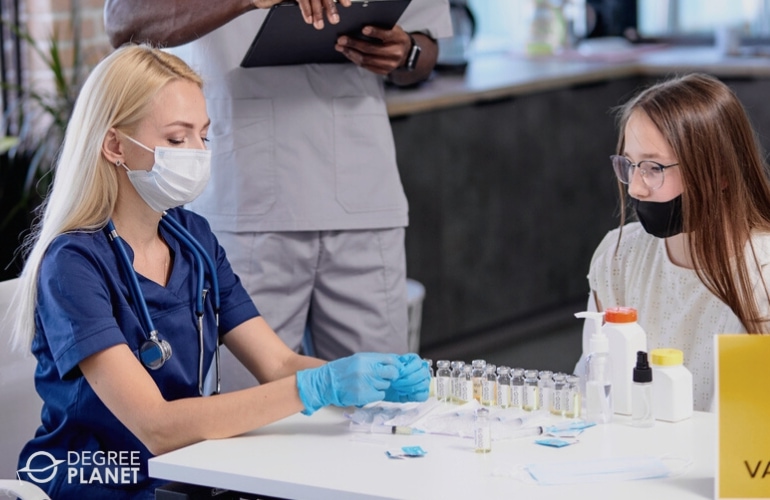What does a medical assistant do? Medical assistants play a vital role in many healthcare facilities to ensure that day-to-day operations and patient care run as smoothly as possible.

If you’re interested in pursuing a career in this field, then it’s helpful to take time to study up on medical assistant roles and responsibilities.
Editorial Listing ShortCode:
As you do, you will learn how medical assistants support physicians and provide essential services for patients, both behind the front desk and in the exam room.
What Does a Medical Assistant Do?

Medical assistants serve as support staff for physicians. They work in the front offices of medical practices and also in the exam rooms. As a result, medical assistant responsibilities often include both administrative and clinical tasks.
On the administrative side, medical assistants may interact with patients over the phone and face-to-face. They may be responsible for billing- and insurance-related responsibilities too. When handling clinical duties, medical assistants might bring patients into exam rooms and collect health information. They can also help with some tests and procedures.
Editorial Listing ShortCode:
Some medical assistants focus on one of these responsibility areas more than the other. In certain job settings, medical assistants may handle administrative and clinical duties equally. Jobs for medical assistants are often found in doctor’s offices. Other places that a medical assistant might work include hospitals, chiropractor’s offices, and outpatient healthcare facilities.
Administrative Duties of a Medical Assistant

To help healthcare facilities run smoothly, medical assistants often take care of various office responsibilities. The tasks can vary based on the job setting, but they often include:
- Answering phones
- Coding tests and procedures
- Communicating with insurance companies
- Greeting patients
- Informing patients about test results
- Preparing billing statements
- Scheduling tests or procedures
- Setting appointments
- Updating records
To do this job well, computer skills are essential. Also, it helps to have a friendly and welcoming demeanor since medical assistants are often the first people that a patient speaks to when arriving at a doctor’s office.
Clinical Duties of a Medical Assistant

In addition to handling office tasks, medical assistants can provide patient care. Each state may have its own regulations about what jobs medical assistants are allowed to do, but their responsibilities often include:
- Discussing health histories and concerns with patients
- Drawing blood or collecting other lab specimens
- Escorting patients to exam rooms
- Giving injections
- Helping with or administering basic medical tests
- Making follow-up calls to patients
- Removing stitches or changing dressings
- Sending prescriptions or refill requests to pharmacies
- Taking vitals (temperature, blood pressure, etc.) and recording the information
Clinical medical assistants often see many patients in one day, so the ability to multitask is helpful. They also need to pay close attention to detail and have a friendly and professional bedside manner.
5 Medical Assisting Careers
The Bureau of Labor Statistics lists multiple allied health jobs that could be a good fit for professionals with medical assistant training.
After completing your schooling, you could pursue work in a traditional medical assisting job or try a related career that draws upon your healthcare knowledge and skills.
1. Administrative Medical Assistant

Someone who primarily handles office tasks in a medical practice may be known as an administrative medical assistant. This professional may greet visitors, book appointments, and record patient data. This job shares responsibilities with several related careers.
Editorial Listing ShortCode:
Administrative medical assistants may do some of the same things as medical secretaries, such as answering phones. Also, by taking care of coding or billing, they may overlap with medical records specialists.
2. Clinical Medical Assistant

Medical assistants who perform patient-care tasks can be called clinical medical assistants. They may work in doctor’s offices, outpatient surgical centers, and hospitals.
Clinical medical assistants often take patients to exam rooms and get them ready for the doctor’s exam. They may also help the doctor by performing tests, gathering lab samples, or removing stitches. In some cases, medical assistants can give shots or medicine to patients.
3. Medical Claims Examiner

Some medical assistants choose to do a job other than working directly with patients. They might offer their expertise to a health insurance company as a claims examiner.
Medical claims examiners review insurance claims to determine whether procedures and treatments are covered under a patient’s policy. They may be asked to review whether certain tests are medically necessary. They might also determine how much the insurance company will pay for services.
4. EKG Technician

Some medical assistants focus on doing a specific type of healthcare task. For instance, it could be possible for medical assistants to become cardiovascular technicians who specialize in running EKG tests.
Professionals in that role hook patients up to electrodes for collecting data about heart activity. The EKG technician then administers tests to see how well the person’s heart is functioning while exercising or resting.
5. Phlebotomist

Working as a phlebotomist is another way that medical assistants can provide health services to patients. Phlebotomists are professionals who draw blood. They may collect other medical samples as well.
Editorial Listing ShortCode:
Hospitals, medical labs, and blood-donation organizations often employ phlebotomists. In addition to obtaining blood samples, the job responsibilities might include keeping accurate records and maintaining a sterile environment. Some employers may require a phlebotomy certificate for this job.
How to Decide Whether a Career in Medical Assisting Is Right for You

Medical assisting is a growing field, so trained professionals are in demand. For that reason, you might be drawn to this career. There are other signs that might indicate that you’d be a good fit for this job.
For instance, you might consider a career as a medical assistant if you:
- Are comfortable with blood and other medical things. In your workday, you’ll probably encounter a variety of germs and bodily fluids. If that doesn’t make you squeamish, then you may be well-suited for this role.
- Are detail-oriented. In medical assisting, the little things matter. You’ll likely be required to take accurate measurements, enter patient records carefully, and submit bills properly.
- Can work independently. You may often be the only person in an exam room with a patient, so you’d be the one in charge of setting the scene and collecting introductory health information.
- Don’t mind taking orders. While it’s true that you may be on your own a lot, a medical assistant’s basic role is to support the physician. You can expect to be given directions and to be expected to follow through as asked.
- Enjoy variety in your days. Medical assistants often spend their days busily hopping from one task to another. Some parts of the day may be spent on administrative tasks, and others might be dedicated to clinical work.
- Hope to enter the job force quickly. Unlike medical school, medical assistant training can typically be completed in 2 years or less.
- Like working with people. Whether in the office or the exam room, most medical assistants interact with a wide variety of patients every day. They also work with an assortment of medical professionals, including doctors and nurses.
- Want to help people. As a medical assistant, you will be there to support people when they’re sick, hurt, or looking for answers to their health concerns.
If you’d like to know more about whether a career in medical assisting is right for you, you could talk to someone who’s currently in the field or to a representative from a college for medical assistants.
Medical Assistant Educational Requirements and Training

Not all employers require medical assistants to have a formal education. Some provide on-the-job training instead. In general, though, it’s strategic to pursue education. Not only can you be better prepared, but you could potentially increase your job opportunities as well.
- Diploma or certificate. If you want to get through your medical assistant schooling quickly, you can earn a diploma or a certificate. These programs usually take less than 1 year. Diplomas are often issued by healthcare facilities that run training programs. Certificate programs are more likely to be administered by accredited schools, such as community colleges.
- Associate degree. For a broader educational experience, you can choose to earn an associate degree in medical assisting. Such programs may take up to 2 years. You’d participate in general education classes and take a full slate of medical assistant courses.
Medical assistant education programs typically cover both the administrative and clinical aspects of this field. Course topics will likely include medical terminology, human anatomy and physiology, medical office procedures, CPR and first aid, and exam room practices.
In addition, many medical assistant programs online or on campus include externship experiences. During an externship, you could work at a local healthcare facility to gain hands-on experience before beginning your job search. Medical assistant college programs often prepare students for industry certification, and your coursework may be tailored toward a specific certification program.
After completing your studies, you’ll likely be ready to take the exam and earn a nationally recognized certification.
Medical Assistant Licensure and Certifications

States don’t typically require medical assistants to be licensed. Instead, many people in this field pursue certification.
Several national organizations offer certification programs for medical assistants. These organizations are the American Association of Medical Assistants, American Medical Technologists, the National Center for Competency Testing, and the National Healthcareer Association.
The certification options include:
- Certified Medical Assistant (CMA)
- Registered Medical Assistant (RMA)
- National Certified Medical Assistant (NCMA)
- Certified Clinical Medical Assistant (CCMA)
- Certified Medical Administrative Assistant (CMAA)
Medical assistant certification sets you apart as a prepared and experienced job candidate. Many healthcare facilities hire only certified assistants. Some look for certifications from a particular organization.
What Is a Medical Assistant?

A medical assistant is a healthcare professional who offers administrative support and clinical care. Medical assistants work alongside physicians to help with whatever jobs need to be done. That could mean answering phones, taking patients to exam rooms, collecting lab specimens, or scheduling follow-up appointments.
Editorial Listing ShortCode:
Medical assistants belong to a group of jobs known as allied health professions. People who work in allied health aren’t doctors or nurses, but they do provide essential healthcare services and support. Like other allied health professionals, medical assistants rely on evidence-based practices as they offer diagnostic and treatment services.
Can a Medical Assistant Give Injections?

Medical assistants can often give injections, but it depends on the rules of the state where you practice. If you live in a state that allows medical assistants to give injections, your job responsibilities might include administering vaccines and allergy shots. You might also be able to perform blood draws.
Some states set specific medical assistant qualifications for giving injections. To qualify, you may be required to go through a training program or become certified. In states that allow medical assistants to give injections, not all jobs include that responsibility. Administrative medical assistants, for example, might not give shots.
Where Can a Medical Assistant Work?

According to the Bureau of Labor Statistics, 58% of medical assistants work in physicians’ offices.
That can include the offices of:
- Cardiologists
- Obstetricians
- Ophthalmologists
- Pediatricians
Working in a physician’s office can provide regular hours and a steady flow of work for medical assistants. The Bureau of Labor Statistics says that another 15% of medical assistants work in hospitals. Others find work with outpatient surgical centers or community clinics. Some are employed by chiropractors, physical therapists, or dentists. Nursing homes may hire medical assistants as well.
What Does a Medical Assistant Do in a Hospital?

Medical assistants with hospital jobs may provide clinical care, such as handing out medication or administering shots. They might also help with various medical procedures. The specific job duties will depend on what department of the hospital the person works in.
Administrative roles in a hospital might include answering phones or directing visitors to patients’ rooms. Medical assistants might also handle scheduling procedures, filling out paperwork, or submitting bills. Some hospital medical assistants work in the lab. For instance, they might analyze blood samples. Medical assistants who work in hospitals may need to work overnight, evening, or weekend shifts.
What Does a Medical Assistant Do in a Clinic?
A medical assistant in a clinic or a doctor’s office may be tasked with entering data into patients’ electronic health records. Assistants can also answer phones, set appointments, and submit bills to insurance companies.
In addition, medical assistants often take patients to exam rooms and prepare them to see the doctor. They might be able to collect lab samples, give shots, or change dressings. Professionals who work in clinical settings often have more predictable schedules than those who work in hospitals. On the other hand, data from the Bureau of Labor Statistics shows that the average pay may not be as high.
Are Medical Assistants in Demand?

The Bureau of Labor Statistics expects jobs for medical assistants to grow by 16% over the next ten years. That equates to about 123,000 job openings each year. The overall growth rate for American jobs is 5%, so medical assisting is certainly a growing field.
Editorial Listing ShortCode:
The baby-boom population is aging, so there’s an increased demand for medical care. Since medical assistants are able to handle a good deal of routine services, they can help relieve the burden on doctors and nurses. For that reason, healthcare facilities will continue to hire medical assistants over the coming years.
How Much Do Medical Assistants Make?

According to data from the Bureau of Labor Statistics, the median annual salary for a medical assistant is $37,190. Most earn at least $29,070 annually, and some make over $48,170 each year.
Pay varies based on employment setting. The highest-paying jobs are often found in outpatient care centers. There, the median salary is $38,270. Hospital jobs take the second-highest spot. The median wage for medical assistants in that setting is $37,800. Experience and training can influence a medical assistant’s salary, too.
The median wage for those who work as medical secretaries and administrative assistants is $37,450. Phlebotomists have a median salary of $37,380 per year.
How Long Does It Take to Become a Medical Assistant?

When considering how to become a medical assistant, most students can meet the medical assistant requirements in 2 years or less. There are several available pathways to becoming a medical assistant.
For an option that often takes less than 1 year, you can pursue an undergraduate certificate from an accredited college. If you can invest a little more time, you may be able to earn a medical assistant associate degree in about 2 years with full-time study.
Many accredited programs include both coursework and an externship. Those learning experiences can provide a strong foundation for employment and industry certification. Many graduates pursue certification shortly after completing their medical assistant studies.
Becoming a Medical Assistant

If you’re looking for a steady, in-demand career that allows you to contribute to others’ health and well-being, then you might consider becoming a medical assistant. In this role, you may have the opportunity to provide both administrative and clinical support in healthcare settings.
Medical assistants are needed in doctor’s offices, hospitals, long-term care facilities, and other settings. Training can help equip you for the diverse demands of this field. In college, you can gain the necessary knowledge and hands-on experience.
If you’re ready to start your medical assistant education, you can take a look at accredited schools where you can earn your medical assistant certificate or associate degree.

